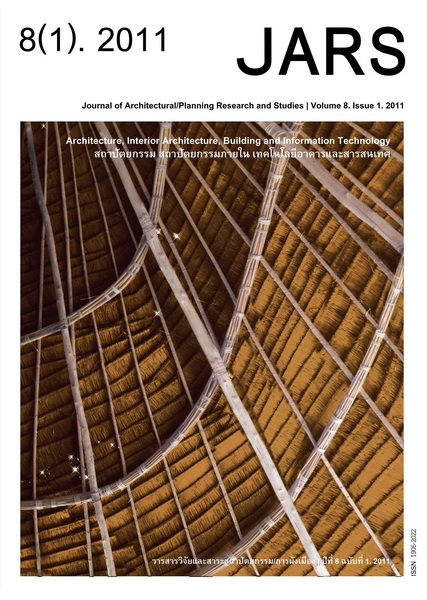Tai Dam’s Longing for Tortoise Shaped Houses: From the Highlands of Muang Thaeng to the River Basins of Thailand
Main Article Content
Abstract
The purpose of this paper is to investigate the ‘tortoise shell’ houses of the Tai Dam (or Lao Song) in
Thailand. These tortoise-shaped houses (TT houses) evolved in the region of Sib Song Chu Tai, in the north
western part of Vietnam. In around the 1800s, the Tai Dam’s knowledge of building construction was shifted to
Thailand with the migration of the Tai Dam group as the result of war. Since then, a substantial number of TT
houses have been constructed and become a distinctive feature of the landscape in Tai Dam communities in
Thailand. However, in the last few decades, the amount of TT houses has radically reduced. The transformation
of the Lao Song’s houses has been catalyzed by modernization. Nowadays, only a few original houses can still
be found in some areas. In addition, reproductions of TT houses were constructed for the cultural exhibition of
the Tai Dam ethnic group. The survival and continuation of these houses demonstrates their unique ability to
withstand contextual, social and cultural changes. On the other hand, the houses of other Tai-Lao ethnic groups
or Tai Dam in Thailand have not only transformed but the original traditional houses have disappeared entirely.
All their houses have been altered to fit the standard design of Thai houses, or constructed in a westerninfluenced
style.
Data for this paper were derived from field-surveys and documentary sources. Comparison and typology
were used for analysis. The discussion mainly related to four types of houses: the original TT houses, the
recently reproduced TT houses, Tai Dam houses in Vietnam, and various types of vernacular houses related to
the Tai Dam. Form, shape, construction elements, materials and structure are the main focus areas. Direct
discussion groups were also undertaken to explore these issues.
Three issues are revealed as follows: 1) the archetypes of TT houses in the past are not exactly the same
as the reproduced buildings, although Tai Dam can construct contemporary reproductions of TT houses with
key elements of the originals; 2) the characteristics of the construction elements are defined and interpreted in
the transforming context of Tai Dam houses; and 3) the clearly articulated identity in their vernacular architecture
shows the Tai Dam’s adaptability to the new context. The Tai Dam have expressed their strong tradition and
culture despite the influence of centralization and modernization, successfully handing down their wisdom and
heritage to their recent generations.
Downloads
Article Details

This work is licensed under a Creative Commons Attribution-NonCommercial-NoDerivatives 4.0 International License.
All material is licensed under the terms of the Creative Commons Attribution 4.0 International (CC-BY-NC-ND 4.0) License, unless otherwise stated. As such, authors are free to share, copy, and redistribute the material in any medium or format. The authors must give appropriate credit, provide a link to the license, and indicate if changes were made. The authors may do so in any reasonable manner, but not in any way that suggests the licensor endorses you or your use. The authors may not use the material for commercial purposes. If the authors remix, transform, or build upon the material, they may not distribute the modified material, unless permission is obtained from JARS. Final, accepted versions of the paper may be posted on third party repositories, provided appropriate acknowledgement to the original source is clearly noted.
References
Chaturawong, C. (1997). เรือนไทดำ: กรณีศึกษาเพชรบุรี [Tai Dam: A case study in Phetchaburi]. Master of Architecture Thesis, Faculty of Architecture, Chulalongkorn University, Bangkok, Thailand.
Dang, B. V. (1990). Some questions on tay and Thai ethnos histories and main cultural features. Proceedings of the 4th International Conference on Thai Studies. Kunming, China, 188-197.
Inpuntung, V. (2011). การกลายรูปในเรือนลาวโซ่ง [Transformation of Lao Song’s houses]. Na Jua: Journal of the Faculty of Architecture Silpakorn University, 7(July-August), 167-187.
Kirdsiri, K. (2011). ภูมิหลังการตั้งถิ่นฐานกลุ่มชาติพันธุ์ไท-ลาว และการเคลื่อนย้ายสู่ประเทศไทย [Historical background of Tai-Lao settlement and movement to Thailand]. Na Jua: Journal of the Faculty of Architecture Silpakorn University, 7(July-August), 83-130.
Oliver, P. (2004). Encyclopedia of vernacular architecture of the world. UK.: Cambridge University Press.
Pinijvarasin, W. (2011). บ้านพื้นถิ่นลาวเวียง...ที่บ้านเลือก [Vernacular houses of Lao Viang at Ban Leug]. Na Jua: Journal of the Faculty of Architecture Silpakorn University, 8(July-August), 217-234.
Punpairoj, P. (2010). การปรับเปลี่ยนความเข้าใจในสถาปัตยกรรมพื้นถิ่นใหม่ [Recalibrating the new Thai architecture]. Journal of Architectural/Planning Research and Studies, 7(2), 65-79.
Saeng-amporn, A. (2008). คุณลักษณะทางสถาปัตยกรรมเรือนพื้นถิ่นไทดำ: กรณีศึกษา ตำบลหนองปรง จังหวัดเพชรบุรี [Architectural qualities and values of Tai-Dam vernacular house: Case study of Tai-Dam village, NhongPhrong, Petchaburi]. Master of Architecture Thesis, Faculty of Architecture and Planning, Thammasat University, Pathumthani, Thailand.
Sribusara, M. (1987). ไทยดำรำพัน [Tai Dam’s longing]. Bangkok, Thailand: Bhannakij Publishing.
Wallipodom, S. (2000). เรือนไทย บ้านไทย. [Traditional Thai house]. Bangkok, Thailand: Muang Boran.


